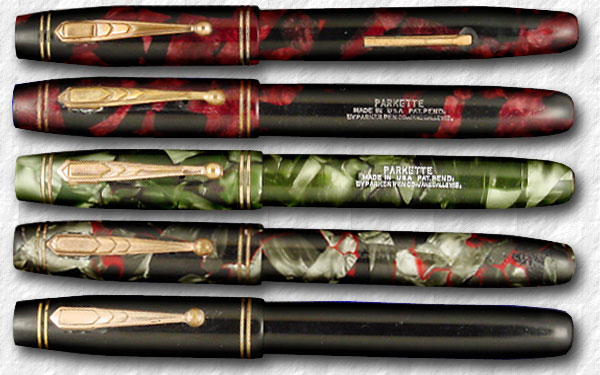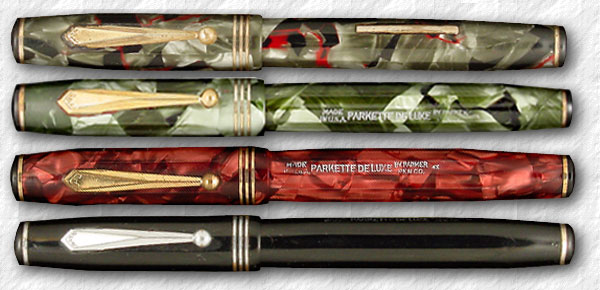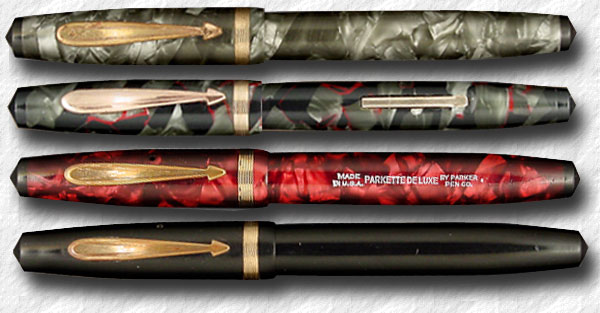
| parkerpens.net |
| PARKERCOLLECTOR.COM |
  Parkers only lever fillers 1932—1941, 1950—1952 |
||
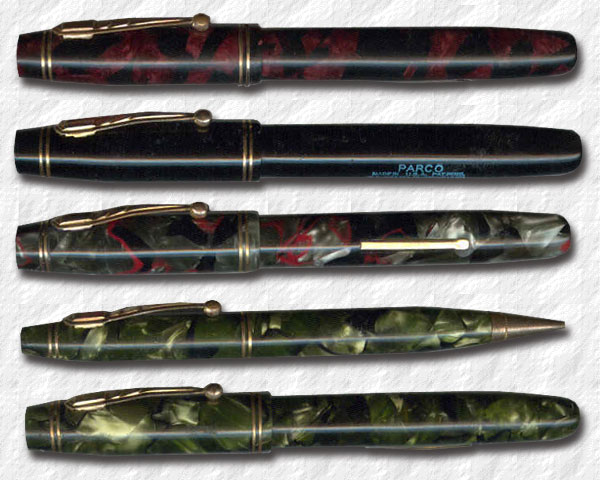 Images © courtesy of Gary Cole |
A collection of 1932 Parcos |
It sported a new kind of ball clip that was riveted into the cap with four "ears" (as opposed to all other Parkers having washer clips held down by a clip screw) and had a design of stepped chevrons and plates. The Parco also had four cap rings, two above the clip and two by the cap lip. |
Images © David Isaacson courtesy of Vacumania.com |
The 1933 Parkettes, note the slight difference in clip design |
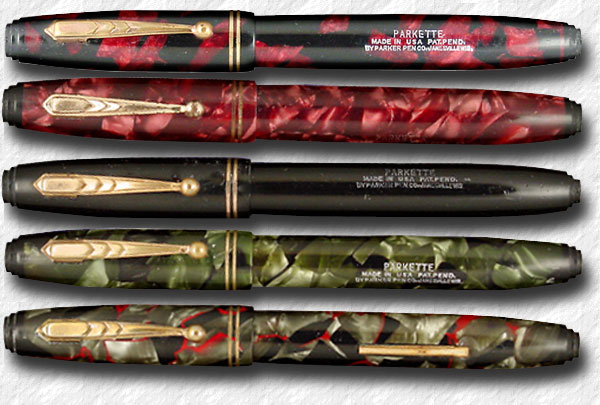 Images © David Isaacson courtesy of Vacumania.com |
The 1934 stepped Parkette "Junior". |
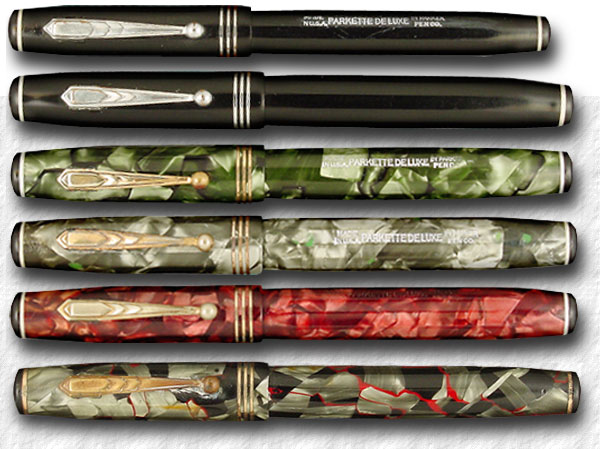
Images © David Isaacson courtesy of Vacumania.com |
A selection of 1934 Parkette De Luxe. The smaller Lady size at the top. |
The top line, Parkette De Luxe, came in two sizes, Standard and Slender. Both sizes had a rounded, white lined, black button on top of the cap and most distinctly, the cap and body was fluted, a number of lenghtwise grooves, unique to this pen. The De Luxe line had three cap bands. All the new Parkettes had gold plated trim, except the Black De Luxe that sported a chromium trim. The white lined top was soon, perhaps in late 1934, replaced by gold filled ones. |
They were imprinted Made in USA PARKETTE DE LUXE/By Parker Pen Co, while the nib was engraved PARKETTE/DE LUXE/PLAT PLT/Made in USA. Both De Luxes sold for $1.75 and the pencil cost $1.25. The pencils were one size fits all. There was also a round chromium plated desk set offered for $3.50, including pen. Although since the Parkette lacked the blind cap, there was no way to replace it with a taper, as was offered with the Duofolds. There are however examples of Parkettes with a black blind cap, quite possibly these were desk pens.
In 1935 the "Junior" pen lost the stepped ends. Somewhat cryptic the 1935 catalogue shows a design with a flat, black top that seems to be very illusive indeed. More common are the rounded versions. The cap still had two bands. the Parkette clip on both lines was also redesigned, losing the attractive chevrons. It was now practically plain, though still a ball clip and still with a point upwards. At the top it had the additional engraving Pat'd. |
Images © David Isaacson courtesy of Vacumania.com |
The 1935 De Luxe with the Pat'd clip and tassie rings in metal. |
Images © David Isaacson courtesy of Vacumania.com |
The last of the De Luxe Parkettes from 1938. |
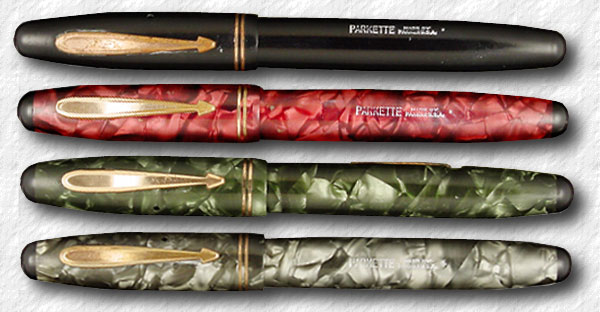
Images © David Isaacson courtesy of Vacumania.com |
The last of the "Junior" 1938. |
| The new Writefine pencils were offered in the solid colours of Black, Red and Blue, a striped Scarlet Blue (that used the plasic of the Striped Duofold Vacumatics of the period) and a Black and Gold Sleeve Writefine pencil. In 1941 also the Parkette Zephyr was being phased our. |
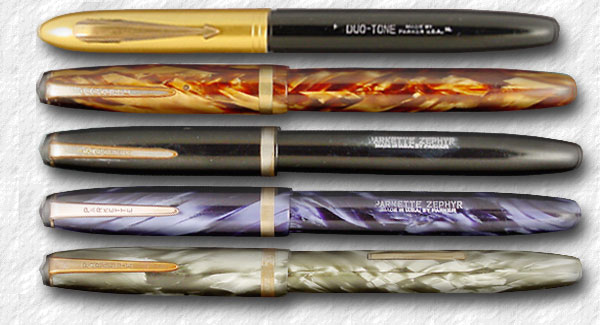
Images © David Isaacson courtesy of Vacumania.com |
Top: Duo-Tone, 1938. Bottom: The Parkette Zephyr, 1939. |
The 1950's Parkette: The pen cost $3.50 and the pencil $2.25 |
The Parkette can be found in many transitional models, many different colour variations and prototypes have been found and more anomalies are constantly popping up. The, let's face it, poor quality of this Parker low end pen, has rendered most items broken, discoloured, severely brassed or cracked. Still the beautiful colours have made them popular among collectors and the rarity of items in excellent condition have rendered them rather pricey. |
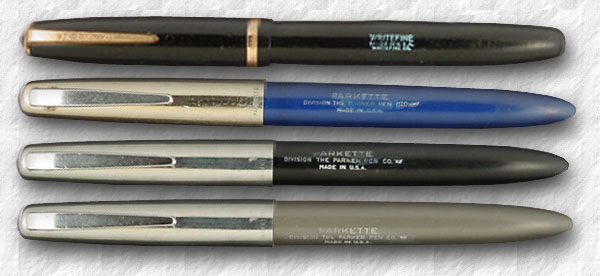
Images © David Isaacson courtesy of Vacumania.com |
Top: Writefine, 1939. Bottom: The New Parkette, 1952. |
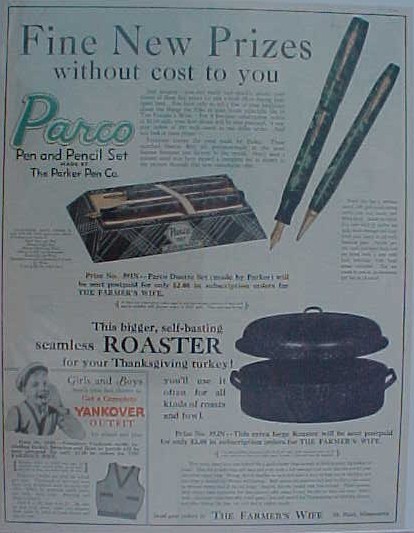
|
Parker Parco ad. |
© 1995-2014 Tony Fischier and The Parker Pen Company®/Sanford Ecriture.
This page is in no way sponsored by or created by the Parker Pen Company®. All opinions, views, and thoughts expressed herein are expressly the authors, and in no way reflect the opinions, views, or thoughts of the Parker Pen Company®/Sanford Ecriture. All logos and/or images on these pages are © Copyright of Parker Pen Company®Sanford Ecritureunless otherwise stated and is reprinted by kind permission. If You feel that Your copyright has been violated please contact the WEBMASTER.
Everything on this website is copyrighted by law and can not be used without written permission from the author, Tony Fischier. You may however use the information as reference material and although it is forbidden to make digital copies or reproductions it may be physically printed for personal use, which does not include use on other web pages or in advertising. You may however quote parts of the content of this website, digitally or physically, providing that the source and author is clearly stated, together with the copyright information. In the US referred to as Fair use. If you use any information on this site, a link is appreciated.
Feel free to donate a small sum through Paypal to help this site to stay online. Acknowledgements.
Parkercollector.com in translated versions


